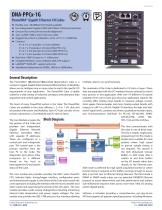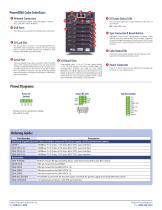
Catalog excerpts

PowerDNA® Gigabit Ethernet I/O Cubes Flexible, over >80 different I/O boards available Two independent Gigabit (1000/100/10Base-T) Ethernet Interfaces One port for control, the second for diagnostics Sync via IEEE-1588 or Inter-Cube sync cable Rugged: 50 g shock, 3 g Vibration, -40 to +70 °C, 0 - 70,000 feet Compact 4” x 4.1” x 2.7” provides 1 I/O slot (UEINet) 4” x 4.1” x 4” provides 3 I/O slots (DNA-PPC5-1G) 4” x 4.1” x 5.8” provides 6 I/O slots (DNA-PPC8-1G) 4” x 4.1” x 6.6” provides 7 I/O slots (DNA-PPC9-1G) Real-time: 1000 I/O scans in < 1 millisecond Complete Windows, Linux, VxWorks, QNX, RTX support LabVIEW TM, MATLAB®, support and more Standalone deployment as UEIPAC, UEISim or UEIModbus General Description: The PowerDNA® (Distributed Networked Automation) Cube is a compact, rugged, Gigabit Ethernet-based DAQ interface. Its flexibility allows you to configure one or more cubes to match the specific I/O requirements of your application. The PowerDNA Cube is ideally suited for a wide variety of industrial, aerospace and laboratory data acquisition and control applications. The heart of every PowerDNA system is the Cube. The PowerDNA Cubes are available in four sizes offering 1, 3, 6 or 7 I/O slots and are packed with power and flexibility. Each I/O Cube consists of two primary subsections: a Core Module and I/O slots or layers. The Core Module occupies the top portion of the Cube and provides two independent Gigabit Ethernet Network Interface Controllers (NICs) with separate IP addresses. These are configured as a control port and a diagnostic port. The control port is the primary interface from the host PC to the Cube. The diagnostics port allows other computers (or a different thread on the host) to interrogate the I/O and system status of the Cube. Block Diagram: The remainder of the Cube is dedicated to I/O slots or layers. These slots are populated with the I/O modules that are selected to match your process or test application. With over 70 different I/O boards available we’re sure to have just what your application requires. We currently offer: Analog input boards to measure voltage, current, strain gages, thermocouples and more, Analog output boards with outputs to ±40 V or ±50 mA, Digital I/O interfaces for logic and “realworld” signal levels, counters and timers, quadrature encoder inputs, and Communications interfaces for RS-232, RS-422/485, ARINC 429/453/708, AFDX, MILSTD-1553 and the CAN bus. The core module also provides provides the 8347 series PowerPC CPU, indicator lights, timing/trigger interface, configuration ports and internal power supply. It’s the brains of the Cube and controls the unit’s operations including the interface with the host Controller (and other Cubes) and supervising the activity of the I/O Layers. The core module provides a wide variety of diagnostics including monitoring internal Cube temperature and power supply voltages. The core module also provides the IEEE-1588 and sync-bus interface allowing United Electronic Industries, Inc. Tel: (508) 921-4600 multiple cubes to run synchronously. The host communicates with the cube in one of three ways. The first is simple, single point, programmed I/O. This mode is FLASH simple and is suitable for most MAC systems where high speed DDR2 or precise sample timing is MAC not required. The second is PPC 8347 the ACB (Advanced Circular Buffer). In ACB mode data is written to and from buffers RS-232 on the I/O boards rather than directly to the Ethernet port. ACB mode is preferred for high speed acquisition/control or where precise timing is required as the buffers are large enough to assure data is not lost due to Ethernet timing latencies. The third mode is DMAP. In DMAP mode cubes use our patented DAQBIOS Ethernet protocol to assure deterministic real-time performance and achieve sub-millisecond response times across more than 1000 I/O (analog and/or digital) points. Software is included, providing a comprehensive, yet easy-to-use API that supports all popular operating systems, inc
Open the catalog to page 1
General Description (continued): Linux, and most real-time operating systems—such as QNX, Intime, VXworks, and more. Additionally, the UEIDAQ Framework—an even higher level Windows driver—supplies complete support for those creating applications in many popular Windows programming languages, as well as data acquisition software packages such as LabVIEW and MATLAB/Simulink. PowerDNA Advantages: Easy to configure and deploy Over >80 different I/O boards available Built-in signal conditioning Gigabit Ethernet based (100/10Base-T compatible) Flange kit for mounting to wall/flat surface...
Open the catalog to page 2
PowerDNA Cube Interface: Network Connectors Dual independent Gigabit (1000/100/10Base-T) Ethernet ports, each with a unique IP address. The USB ports are accessible in the UEIPAC series of the Cubes. The SD Card slot is not active in the standard DNA-PPCx-1G, PowerDNA mode of operation. However, the SD Card along with an internal solid-state disk drive are available for local storage on the UEIPAC series of the Cubes. Sync Connector & Reset Button High-speed Cube-to-Cube synchronization connector allows multiple cubes to be sychrnonized. The reset button is Recessed to prevent accidental...
Open the catalog to page 3




